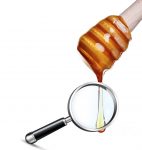Follow the Honey: Safeguarding Food Integrity Using Integrated Informatics
Manuka honey is a monofloral honey produced in New Zealand and Australia from the nectar of the manuka tree. It is purported to have a number of health benefits, which in recent years has been touted by celebrities and health-food gurus alike. Partly due to its star-appeal, manuka honey is amongst the most expensive honeys on supermarket shelves.
And it seems we can’t get enough of the stuff. An estimated 10,000 metric tons are consumed globally, according to figures from New Zealand’s Unique Manuka Factor Honey Association.7 However, with New Zealand’s manuka honey production set at just 1,700 metric tons annually, it’s clear that something suspicious is going on in the supply chain.
Manuka honey’s premium price tag and low market availability makes it a prime target for counterfeiters, who extend the product through adulteration with lower priced sugar syrups. This fraudulent activity has the potential to seriously damage consumer confidence and significantly impact sales revenues.
Action was needed to protect the interests of New Zealand’s manuka honey producers. A trade association for producers was established, and investment was made in establishing accredited methods that could be used to positively identify manuka honey. A standard set of properties and storage conditions required to prevent product degradation were defined to enable importers to verify the provenance of manuka honey using these analytical techniques.
Given the large volumes of data associated with large-scale honey analysis and the need for supply chain traceability, an integrated informatics solution can play a vital role in simplifying this process and safeguarding data integrity.
Identifying and quantifying specific components in a complex matrix such as honey requires both consistent preparation and reliable analysis techniques. Using a laboratory execution system (LES) to ensure analysis methods are followed according to standard operating procedures can help to deliver more reliable, consistent, and legally defensible results. Additionally, with analytical data stored securely within a centralized laboratory information management system (LIMS), and shared and accessed through a scientific data management system (SDMS), authorized users can conveniently retrieve and visualize data without logging into the original instrument – wherever they are in the food testing workflow. Paperless and integrated solutions like SampleManager LIMS, with built-in CDS, SDMS and LES, ensure that in the event of an audit or legal case, the data can be traced all the way from the analytical instrument right through to the analyst’s conclusion.
References
- O. Escuredo, et al. (2014). Contribution of botanical origin and sugar composition of honeys on the crystallization phenomenon. Food Chemistry, 149, 84–90.
- J.W. White. (1992). Journal of the Association of Official Analytical Chemists, 75, 543–548.
- J.F. Cotte, et al. (2007). Study and validity of 13C stable carbon isotopic ratio analysis by mass spectrometry and 2H site-specific natural isotopic fractionation by nuclear magnetic resonance isotopic measurements to characterize and control the authenticity of honey. Analytica Chimica Acta, 582, 125–136.
- Association of Analytical Communities (AOAC) official methods of analysis method 998.12: C-4 plant sugars in honey, internal standard stable carbon isotope ratio method. (1999). AOAC Int. Gaithersburg MD (USA) , Chap. 44, 27–30.
- L. Elflein and K.P. Raezke. (2008). Improved detection of honey adulteration by measuring differences between 13C/12C stable carbon isotope ratios of protein and sugar compounds with a combination of elemental analyzer – isotope ratio mass spectrometry and liquid chromatography – isotope ratio mass spectrometry (δ13C-EA/LC-IRMS). Apidologie, 39(5), 574–587.
- A. Cabañero, J.L. Recio, and M. Rupérez. (2006). Food Chemistry, 54, 9719–9727.
- S. Creasey. (2014). The great manuka honey swindle? The Grocer.









which brands of honey or countries of origin of honey adulterate their product?